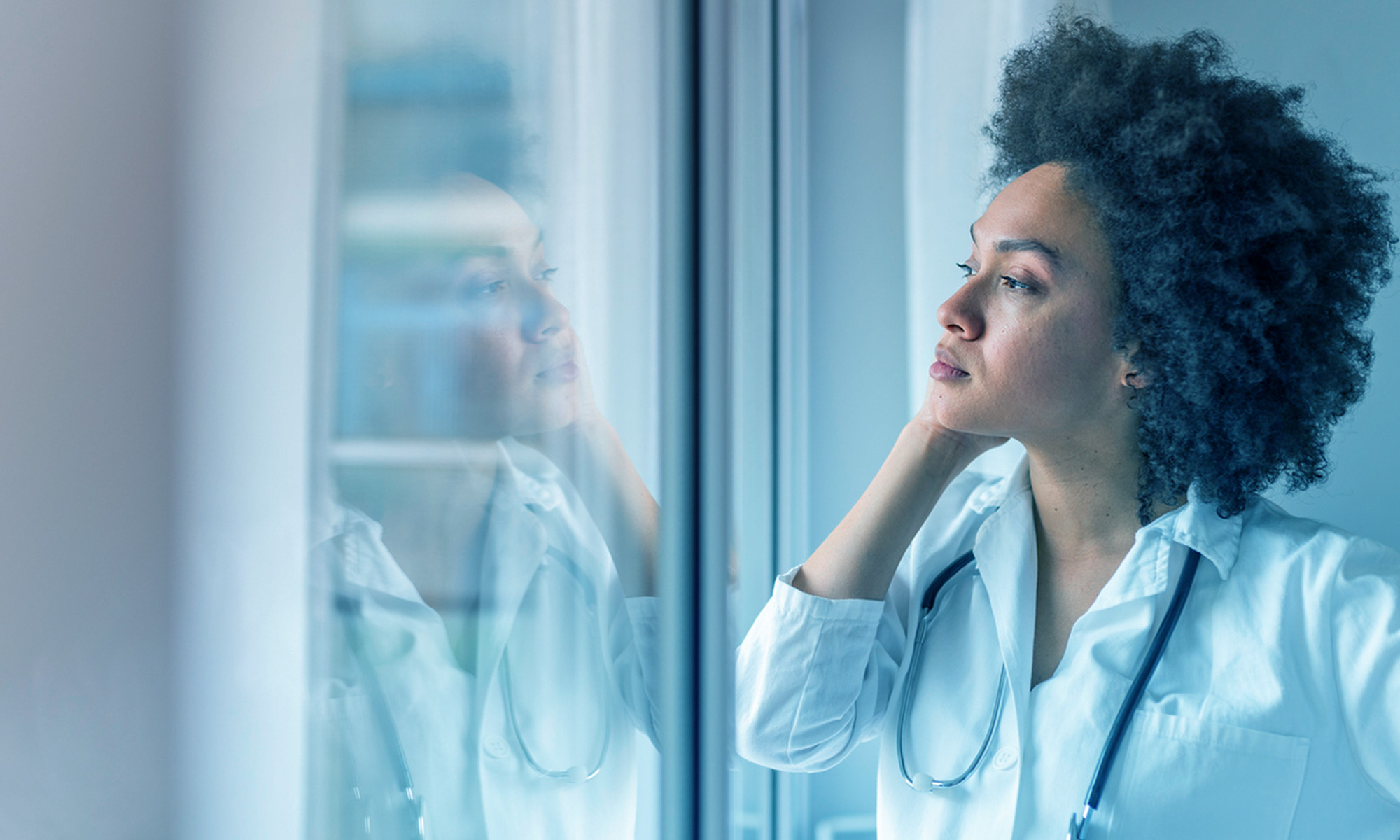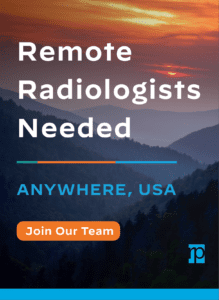The following conversation includes topics such as depression, burnout and suicide. If you or a loved one would benefit from additional support, please reference the resources included at the end of the Q&A conversation.
A 2019 study cited that radiology ranks fifth among specialties in burnout. While this study was conducted before the COVID-19 pandemic, the global health emergency has likely exacerbated the problem. Recently, three Radiology Partners (RP) colleagues discussed the topics of burnout, depression and suicide, particularly within the healthcare community.
Melinda Collins (MC): Given that September is Suicide Prevention Awareness Month, we wanted to host a conversation with two experts within the Radiology Partners community who care deeply about the topics of burnout, depression and suicide. Dr. Chris Mattern serves as Associate Chief Medical Officer for Radiologist Experience for RP. He partners with practice leaders across the country to provide tools and resources to support RP radiologists. Dr. Mattern is a neuroradiologist and is the practice president of Greensboro Radiology in North Carolina. Dr. Syam Reddy is a radiologist with RP Chicago, where he serves as clinical chairman at UChicago Ingalls Memorial. Dr. Reddy has served as a leader to establish RP’s Wellness Committee and remains deeply committed to and very involved in many of the wellness initiatives that we have rolled out across the country. Dr. Reddy specializes in both body and breast imaging.
It’s important to acknowledge that none of us are mental health professionals. We are colleagues who are passionate about bringing these topics to the forefront and facilitating a discussion about them. Perhaps it’s important to begin by clarifying the differences between burnout and depression, because these terms are not synonymous.
What are we talking about when we talk about burnout, and what are we talking about when we talk about depression?
Dr. Syam Reddy (SR): Burnout and depression are somewhat different but also pretty similar. It’s interesting to have that discussion. When we think about burnout or when we read about burnout, a lot of times it’s referring to environmental situations. A lot of times its work-related, for example, and the stressors that you’re feeling because of that lead to burnout. But when we talk about depression we’re going more into the clinical realm where we’re starting to diagnose, and there is a lot of overlap. There’s some research now saying that treatment can be pretty similar for burnout and for depression, and I see depression as being a little bit broader – so there’s different things that can result in depression, versus burnout being more environmental. So those are some differences and similarities.
MC: I’m curious if you could share some personal experiences or observations that have led you to be so passionate about this discussion and these topics?
Dr. Chris Mattern (CM): Well, I think when we talk about mental health issues, it’s something that over time in our society, we’ve been reluctant to talk about, and I’m thankful that some of those barriers are coming down. I think we know that most people have people they know who have suffered from depression – one of the most common entities in mental health – but addiction and more severe entities as well. Being able to talk about these things more openly is helpful. I have family members that have suffered from various forms of depression, and even dating all the way back to high school, I have had more than one friend and acquaintance whose depression has led to such a point that they have taken their own life and suicide, and have witnessed firsthand the impact that has on the people closest to them and on those communities even at a larger perspective. We’ve seen that happen within our practice at RP, as well, and the impact of asking ourselves questions like “What could I have done to help?” and maybe even thinking that we need to take on some responsibility over these events, believing that had I done this particular thing I could have prevented that suicide. I think the literature tells us that’s not necessarily the case, and we often take on that additional responsibility.
At the same time, I think we can continue to learn how to be more available to each other and learn how to ask for help when we need it. So as physicians, we see ourselves as being very capable, and we are. We tend to be less able to ask for help, and as our work requirements continue to build, our business builds. We are more and more isolated, even outside of the pandemic. These are all factors as Dr. Reddy was speaking of that lead to additional burnout and in a situation where depression is at play as well, unfortunately, the two entities can build upon one another. So, I’ve seen it in my family, I’ve seen it in my education, I’ve seen it in the workplace, and I believe that there is more we can do to connect and help out our colleagues and friends, within both realms of burnout and depression to avoid some of these worst outcomes.
MC: Dr. Reddy, can you tell us more about why you care so deeply about these topics? You’ve been so involved in -RP’s initiatives in particular—what drives that passion for you?
SR: Back in 2016 I was at a different hospital, and the group I was with was very much on top of progressive imaging and high-quality standards of care and that sort of thing. We found out suddenly from the health system that they needed to move in a different direction, and we had about six months left with them. So, it was very shocking for us, and at that moment knowing that we had to work as hard as we did and even harder knowing that we were leaving soon, and people already started leaving. It was a very difficult time, and I was leading the practice at that time as well, and so being a leader in that situation was really difficult – knowing that things were falling apart. I could feel that same sense of despair with my partners, and trying to understand my feelings, I’d reach out to my sister, who’s an ED physician with a background in integrative medicine, and she’s the one that started me looking into burnout and learning about it. It really clicked into some of the feelings I had, and why I was having them, and I realized it wasn’t me that was just going through these things, and I wanted to be part of the solution or to help people that had those kinds of experiences. That was the main motivation, and since then, there’s just been so much information and so much positive feedback from doing things to help people with burnout that I feel grateful to be able to do that.
MC: It seems as though mental health topics are particularly difficult to grapple with in the healthcare community. What do you make of that?
SR: You know, it’s interesting, the healthcare system. It’s a very different culture when you compare it to many different types of business organizations, for example. I think that has to do with the initial culture when you go through training. We’re kind of that group of people that are mentally wanting to serve, and we’re trying to serve and not complain at the same time, and there’s a culture in training where if you show any weakness, then you’re not good enough. You know, that’s kind of what’s been there, especially in the past, and I really do feel like that’s slowly starting to change as we talk more about things like this. But I think that’s been the roadblock for so many years, and that’s what’s made it difficult for people to reach out when they’ve had issues. On top of that, many physicians and healthcare workers are worried about their licensure, when you start reporting any kind of mental illness issues that can reflect poorly on your credentials and make it difficult for you to practice. I think that’s a real concern that people have. So those are the two main things that I can think of.
MC: Dr. Mattern, what would you add to that?
CM: I think that has been the culture and continues to be largely the culture within healthcare and particularly at the physician level that has attracted people that are highly capable and have often made it very far in life without asking for a lot of help and just haven’t learned how to do that along the way. I think I would add that we don’t have a lot of mentors to look at as we sort of are starting to see some culture change on this. There isn’t a lot of senior leadership, and so I applaud, you know, folks like Syam who are willing to step forward and take on some of these roles to make it okay to talk about this. But when we look across some of our education centers, we’re now starting to teach some of this in medical schools. I don’t know that there’s been a whole lot yet in residencies. This is an opportunity, I think, for us to continue to transform radiology, transform medicine in general, to be willing to have these conversations. But that lack of senior leadership on it, which I think is typical of many cultural changes when we’re in the middle of it, is another component that’s there that I think we can continue to move on.
MC: The U.S. Senate just passed, in August, the Dr. Lorna Breen Health Care Provider Protection Act, to start to turn the tide on this conversation from a federal level. This legislation was backed by the American College of Radiology (ACR) and many other healthcare organizations to provide training for health professions students, residents and professionals to prevent suicide, in particular burnout and mental health conditions, and substance use disorders in the healthcare community in particular.
CM: I think the Lorna Breen Health Care Provider Protection Act is an example of where, sometimes, forces outside of our space can sometimes see things that we can’t and again being open to that. There are other times where there are forces that are trying to move things that ultimately don’t make sense, but in this case, where we sometimes can’t ask for help ourselves, receiving that outside feedback and in this case support through the Senate is also another hopeful sign.
SR: I totally agree with Chris, and hearing about the U.S. Senate pass that legislation, I think that’s so hopeful because now organizations will have some kind of resource to fund wellness committees, for example. You know, some of the larger practices are able to invest, which is great, but when you’re talking about everybody in the country and smaller practices that don’t have resources, this is a huge step in the right direction. I look forward for that to be fully implemented.
MC: We read a lot about physician burnout and of course physicians have a very highly stressful career. It’s very time consuming, and physicians are literally dealing with life and death. Of course, the healthcare community is comprised of so many other professionals, and I know both of you are very passionate about physician burnout prevention but also the support team burnout prevention. I’d love to hear from both of you on that topic as well because so many of your colleagues are non-physicians or even non-clinical in nature.
SR: I can’t say enough about how we need to encompass the whole healthcare system when it comes to issues of burnout. I know we’ve been talking about physician burnout, and I do think there’s differences between people in different areas of healthcare, but we all share the pressures. So, you know, if the physician is dealing with issues, that overflows into nurses and secretaries and administrators, and so how do we work together to ensure that we, as a team, are effectively preventing burnout, you know, helping each other in times of need – feeling comfortable that we can open up to people, even if they’re not a physician, for example, or vice versa. I think that’s important because that all effects the culture, and it’s the culture that really needs the change.
CM: Right, I mean within RP we have over 2,500 radiologists now. We have over three times that number of support teammates that are working side by side to fulfill the mission, and when any one of us is experiencing our stress in ways that are counterproductive and negative, that has a ripple effect on everybody around us. Sometimes given the hierarchies that exist within practices between physicians and other teammates, we see that physicians are sometimes acting out in ways that are allowed or have been traditionally permitted, that are very toxic to those that are around them. Not to say that non-physicians don’t act in that same way. So, being really cognizant of the impact that our behaviors have on others, learning how to deal with the stresses that we have, how to recognize the burnout, how to understand the reality of depression and other mental health afflictions so that we can get the health the same way that we would for other organic disease, recognizing that we’re all part of this team, and that if we were just a group of physicians, we would get nowhere. We each have our work life, we each have very demanding schedules, we each have our home lives and other stressors that exist, particularly in the midst of everything going on and the world today. Between the pandemic, civil unrest, various civil rights issues that we continue to see every single day. So, it has to be a holistic approach and I’m very thankful, again, for the work that Syam’s done with the Wellness Committee and the inclusiveness of our support teammates. Knowing that, as we support one another, that’s one of the best things that we can do to really help with all of these issues.
SR: It speaks volumes that RP’s invested in our chief medical officers, associate officers, such as Chris, in these endeavors because that means leadership is investing in wellness, which is a huge step in the right direction. Just like Chris is saying, the holistic approach is best, trying to change the culture and include everybody in the process. So, I whole-heartedly agree with that and think it’s really important.
CM: I think, to that end, you know, Melinda, some of the things that we’ve been able to do at RP that are supported by the Culture and Leadership Team and the Wellness Committee, some of the work that I’ve been able to do as well through radiologist experience, which again we want to reach out as well to teammate experience. But monthly sessions that we do with some executive coaching in a program called RP Relate where we’ve created space for both physicians and support teammates to come forward and just talk about things that are going on, recognize that you’re not alone and get some support. We’ve established coaching circles, where we have groups of 10 or 12 people and, again, Syam has been very involved early on in setting up these coaching circles, and we’ve not isolated physicians and support teammates, but I think actually, you know, and I’ve been involved in a few of these now, maybe Syam, you can share your experience as well, but the very fact that these crossover between support teammates and physicians, I think allow us to see one another more wholly support one another. I think understanding that all these various stressors that we deal with are not unique to just me, not unique to Syam, or to you Melinda or anybody else, but these are shared human experiences, and so I’m very thankful to those coaching circles, the RP Relate work and what we’ve done around belonging and really understanding the different cultures and experiences we bring together as national practice, that we’ve done that in a very holistic and inclusive way for both physician and support teammates throughout the practice.
MC: Thank you for pointing that out, Dr. Mattern. I think you’re right. I’m part of a coaching circle that is comprised of radiologists and support teammates, and that’s exactly the experience that I have had is that it brings us together as humans, first and foremost, versus, the hierarchy that you mentioned previously. We’re all just humans here, and we all bring different experiences to the table and can help one another, to relate to one another, to coach one another. And ultimately, it’s helpful in our work as collaborators. Dr. Reddy, anything you would add to that?
SR: I can’t say enough positive things about coaching, especially that’s something I’ve been really interested in learning about and participating in and hoping to facilitate, because I think it’s a great way to have people relate to each other from different practices across the country, and just realize that, you know, you’re not alone when you’re going through something. A lot of times people are going through the same thing in different ways. On top of that, it allows us the space to grow and develop, and I think that’s really important – all of those things are important to prevent burnout.
CM: If I can add to that, you know just within the coaching circles, it’s not just being able to spend six months and developing more connection with those people, but Syam, you were one of the first developing both physician and support teammates as coaches and providing real executive coaching level training on how to be a coach, which then provides more resources at your local practice and in other places that you’re interacting where you have a different understanding of how to even have some of those conversations, which I think is another really cool piece of that whole program.
SR: I agree that coaching circles help both at home and at work, and it results in a positive influence in people all around. It’s helpful both at work and at home life. It increases awareness to help people and grow as a person.
CM: Melinda, I’m going to flip the tables for just a second: What has that impact been on you and being part of a coaching circle, where it is with physicians in your circle who are being vulnerable on how you think about your role and how you think about the practice?
MC: To answer succinctly, it offers a different level of empathy that I would not otherwise have, because it’s really easy in healthcare organizations to view physicians, in particular, as on a pedestal, as superhuman, as untouchable emotionally and that’s just not true. At the end of the day, we are all suffering from the human condition. We’re all humans, and I think that the resources that RP has put in place have allowed me to really see all of my colleagues as human. We’re all equal when it comes to the human condition. So, I think that’s really what it has done for me personally and professionally, because then I go into my work with a healthy dose of empathy.
CM: That’s great. I would love for that message to get to as many physicians and support teammates as possible because I think, and Syam, tell me what you think, part of what leads to this burnout is the sense that I’ve got to take on all of these things, and knowing that as a physician, I can be seen as vulnerable, it is okay. I’ve got support teammates like Melinda who can now get that differently through some of this work is helpful and maybe helps release me a little bit from that burden that I feel like I have to carry otherwise. Your thoughts, Syam?
SR: That’s such a great point you make. I think a lot of us hold in a lot when it comes to carrying our own burdens and, you know, doing what we are doing. I think, I’m hoping, that people will be able to loosen that burden because they’re developing trust in our teammates, other physicians, the practice and helping to carry that load all together. Because together, we’ll be stronger that way.
MC: What do you think the future might look like as we continue down this more progressive path of addressing burnout, of addressing depression at work and preventing depression turning to suicide? What could the future look like for healthcare organizations like RP and others?
SR: A lot of times we’re focused on what should we do right now, but it’s a good question to ask, and I think the future would be, you know, not just bright but it would really turn things. You know, right now, we’re in a shortage of radiologists, and there’s a lot of stress with understaffing for nurses, for example. You know, a lot of that has to do with what people consider the healthcare workforce is like. You know, what if we changed it so it was more, you know, enjoyable, more open or brighter and not so intense. You know, so I just think the future would look so bright if it was open that way and, you know, we had more people, more diversity. So, yeah, very positive, no question.
CM: Building on that, just asking organizations to have the courage to have these conversations, and I think there’s a number of lessons that we can learn from the pandemic. I think we have been forced to look in the mirror and understand our interdependency. To understand how much we rely on others, as we have been more isolated, and then that we’ve found ways to connect that we’ve may have never thought about before, and so as much as we’re all frustrated and ready to be done with these Zoom and WebEx meetings and everything else, there’s probably some future role that helps us connect, you know, across a national practice that helps us connect in ways that you know otherwise would have been reliant on in-person meetings, which I’m so looking forward to getting back to and having that as part of it, but I don’t think it’s a binary decision. So looking at the ways that we’ve learned how to connect with one another when forced into isolation, hopefully are things that we can continue to develop that connectedness, which I think has been shown to be one of the most important things in combating burnout – is just removing those barriers of isolation, developing connectedness, understanding our interdependency, and, and building on some of these things that we’ve been somewhat forced to learn how to do.
MC: What gives you hope for the future?
SR: I think what gives me hope is being able to participate in things like this, knowing that there’s more people wanting to learn about this, wanting to listen to this and wanting to be part of this process. I think it’s a powerful movement, sort of feeling and its invigorating and inspiring to know that we’re doing such great work. So, thank you for having us and giving us space to discuss this important topic.
CM: I think on large-scale practices like RP and many other large-scale corporations are stepping up and just taking a bigger role in environmental issues, in wellness and mental health issues, without being forced into those things by policy and government but understanding really what even their financial ROI is on that, on creating a more connected society. So, I’m thankful for that, and thankful to be part of a group that is willing to have this courageous conversation, and then thinking back to something that Syam said just a little bit earlier, I think the increased conversation that is happening among some of our younger partners around the reality of work-life balance and sustainability, and that’s leading us to conversations about how do we really create a sustainable model where we can serve other people over the long term, which is our mission, but remember that we need to put our oxygen mask on first and make sure that we’re looking after ourselves as well to be able to take care of others. So, I’m thankful for many of those courageous conversations that are happening on very large and very small scales.
MC: Thank you, Dr. Mattern and Dr. Reddy. Thank you both for this conversation. Again, that’s exactly what it was, today – a conversation. We are not mental health professionals, and we will have resources available for anyone who needs access to mental health resources, and for our RP colleagues, our Employee Assistance Program is also available. Thank you both.
Resources:
- National Suicide Prevention Lifeline | 1-800-273-8255
- American Foundation for Suicide Prevention: Resources for Healthcare Professionals
- American Psychiatric Association: Well-being Resources for Healthcare Professionals
- For RP colleagues who need access to the Employee Assistance Program, visit RadWiki or email benefits@radpartners.com.
Dr. Syam Reddy is a radiologist at RP Chicago, Dr. Chris Mattern is the Associate Chief Medical Officer for Rad Experience and Melinda Collins is Director of Communications at Radiology Partners, a leading physician-led and physician-owned radiology practice in the U.S. For the latest news from RP, follow along on our blog and on Twitter, LinkedIn and Instagram.






